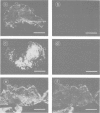Abstract
1. Angiotensin II (AII) reduces blood flow, modulates vascular remodelling and is a growth factor. Human inflammatory arthritides are characterized by synovial hypoperfusion, hypoxia and proliferation. We aimed to localize and characterize receptors for AII in human synovium. 2. We used quantitative in vitro receptor autoradiography with [125I]-(Sar1, Ile8)AII and [125I]-AII on human synovium from patients with chondromalacia patellae, osteoarthritis and rheumatoid arthritis. 3. [125I]-(Sar1, Ile8)AII and [125I]-AII bound to similar sites on synovial blood vessels, lining cells and stroma. Binding to microvessels (< 100 microns diameter) was more dense than to arteriolar media, and vascular binding was more dense than that to lining cells and stroma. 4. Microvessels and arterioles which displayed angiotensin converting enzyme-like immunoreactivity also displayed specific binding of [125I]-(Sar1, Ile8)AII. 5. Specific binding of [125I]-(Sar1, Ile8)AII to each structure was completely inhibited by 10 microM dithiothreitol and was inhibited by unlabelled ligands with the rank order of potency (Sar1, Ile8)AII > AII > losartan = SKF108566 > PD123319 indicating an AT1 subclass of angiotensin receptor. 6. GTP gamma S (1 microM) abolished specific binding of [125I]-AII and abolished the high affinity component of the binding inhibition curve for AII against [125I]-(Sar1, Ile8)AII, indicating G protein coupling. 7. The distribution of [125I]-(Sar1, Ile8)AII binding sites was similar in all disease groups and no significant differences in binding densities, affinities or specificities were observed between disease groups. 8. Locally generated AII may act on synovial AT1 receptors to modulate synovial perfusion and growth. Specific AT1 receptor antagonists should help elucidate the role of angiotensins in human arthritis.
Full text
PDF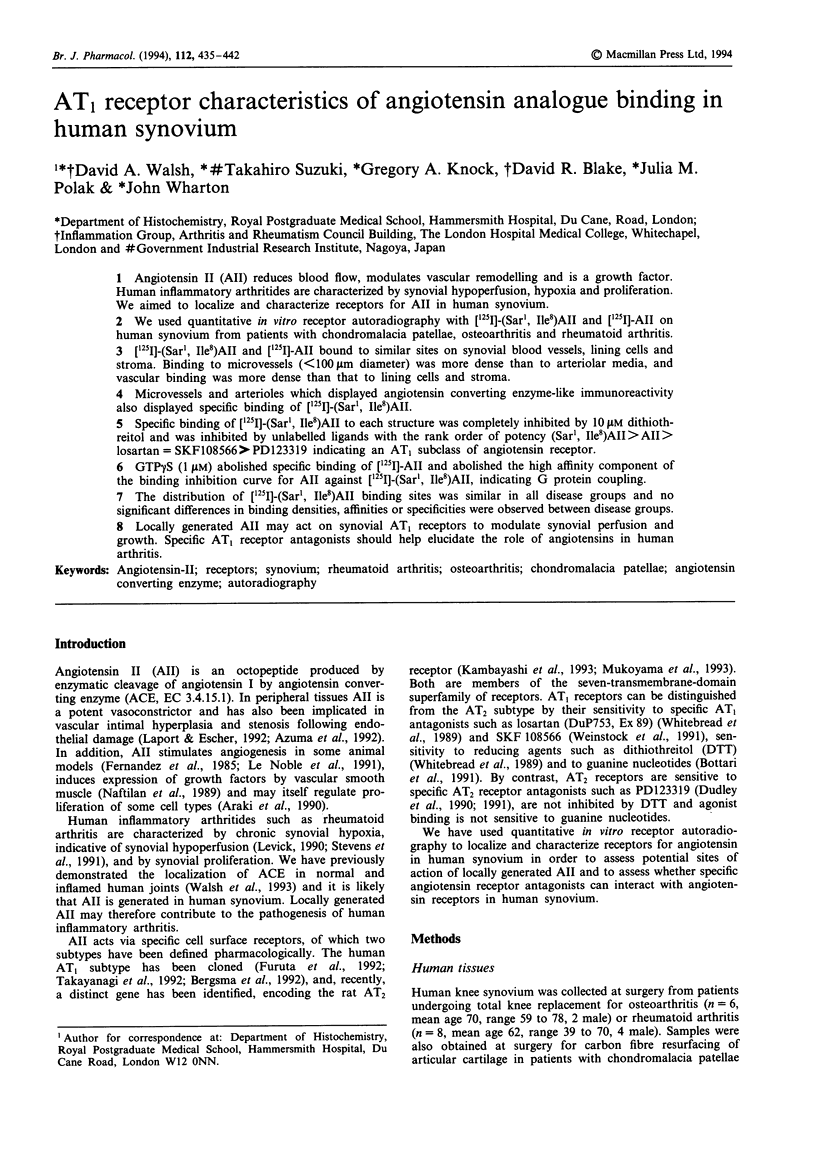
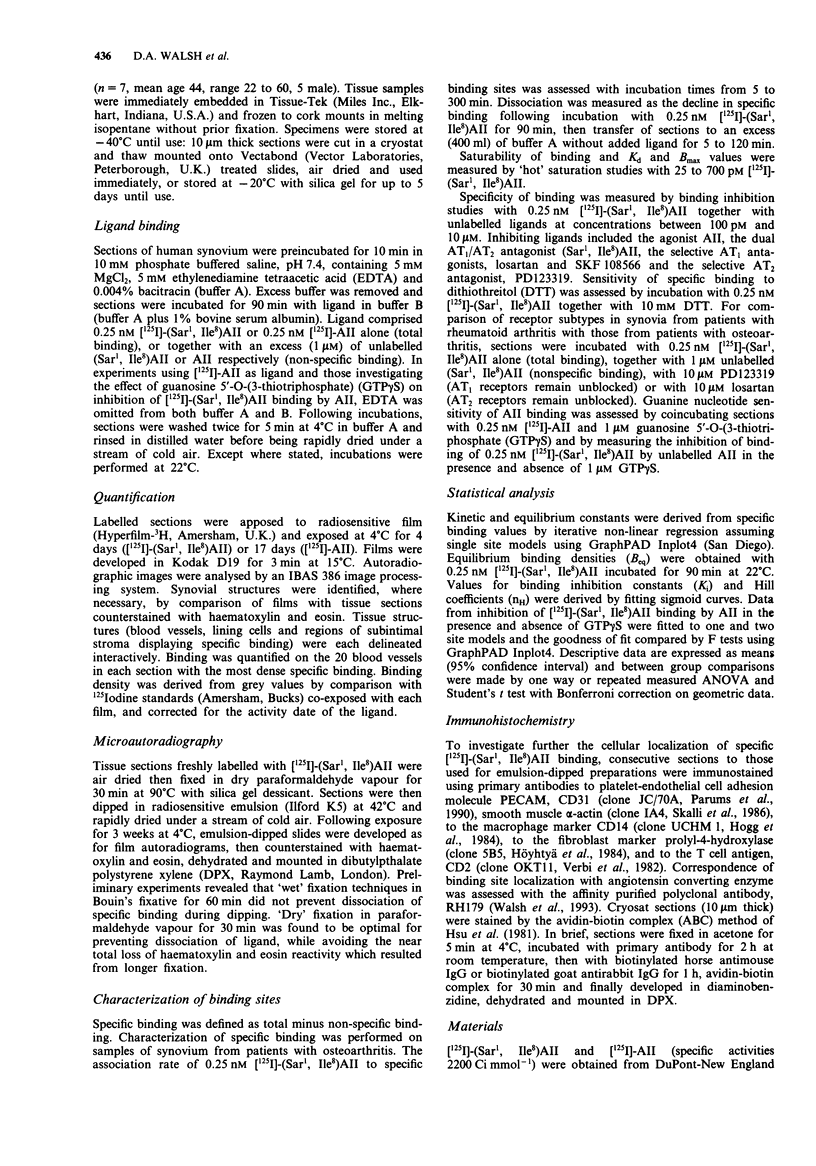
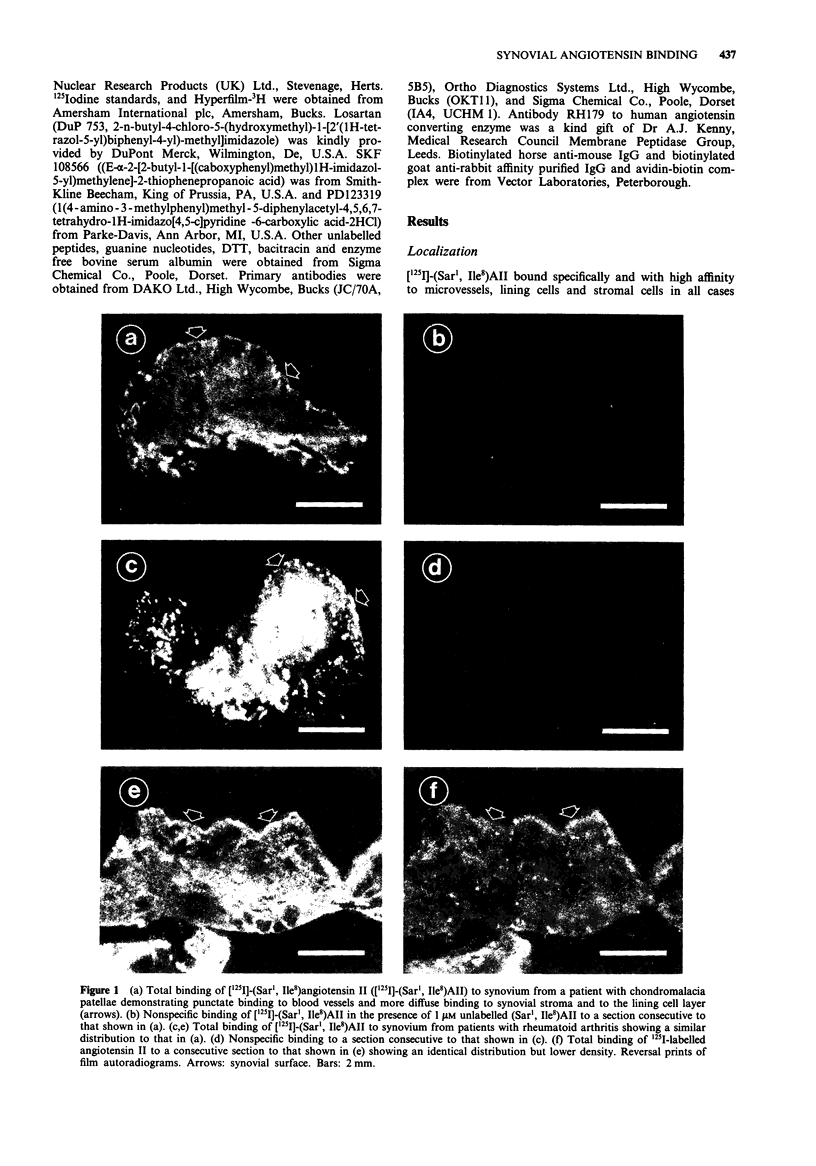
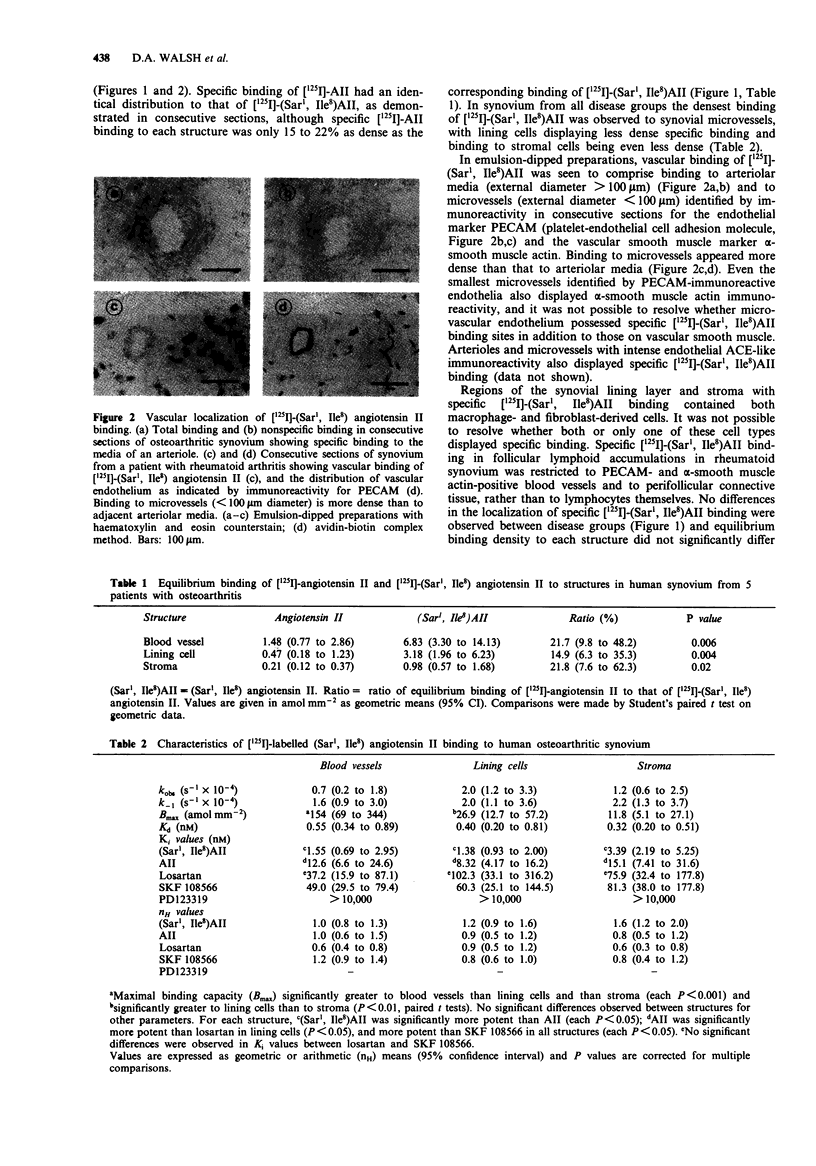
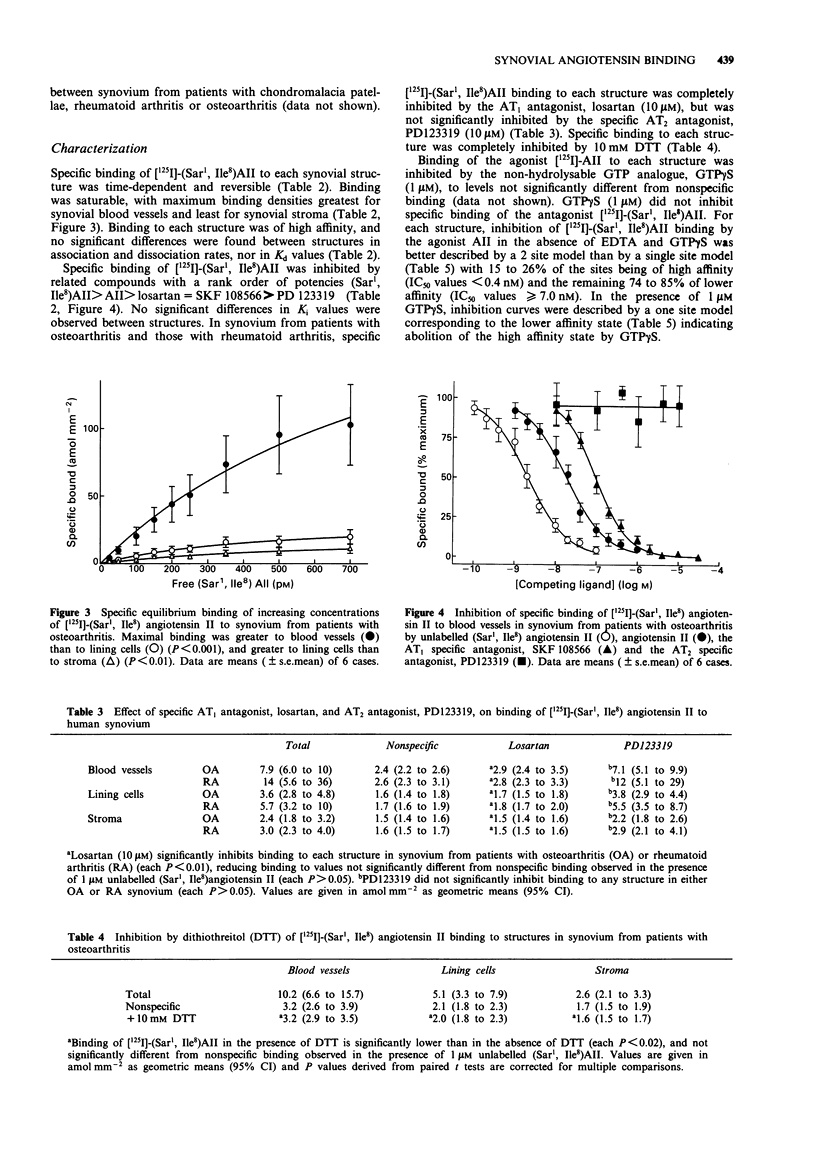
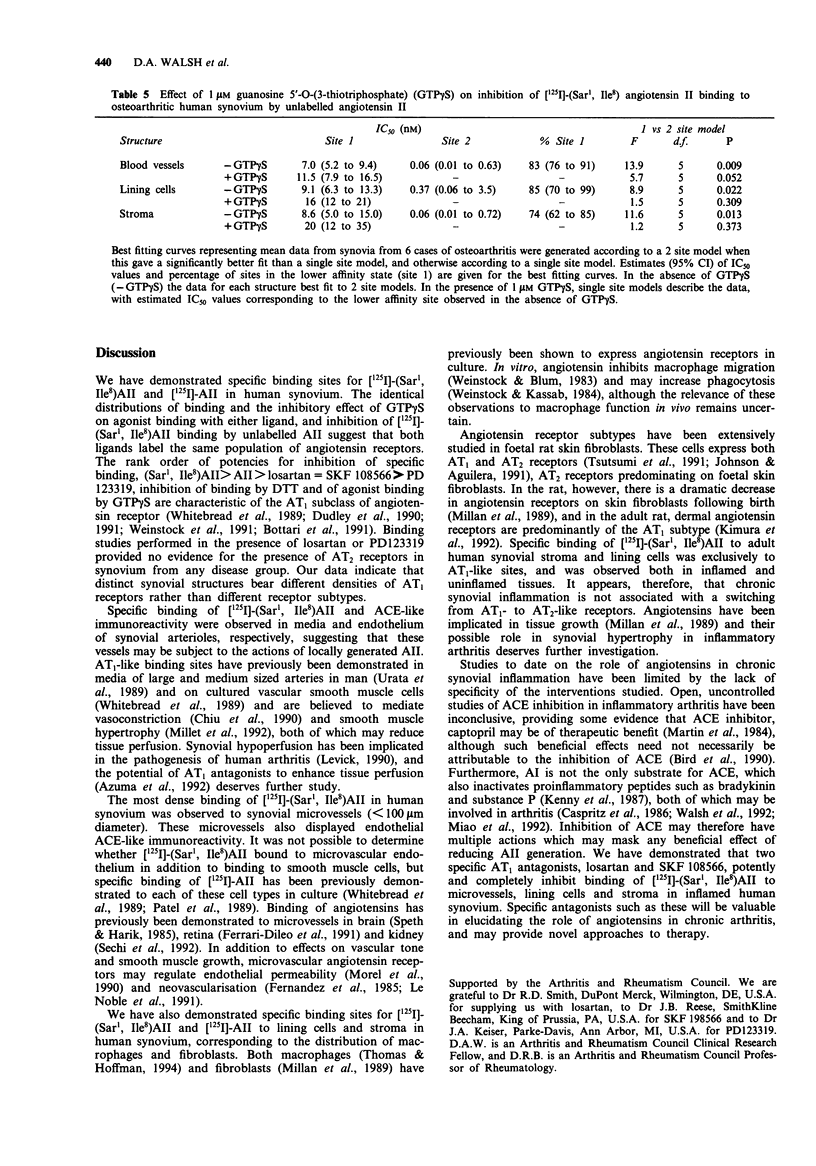
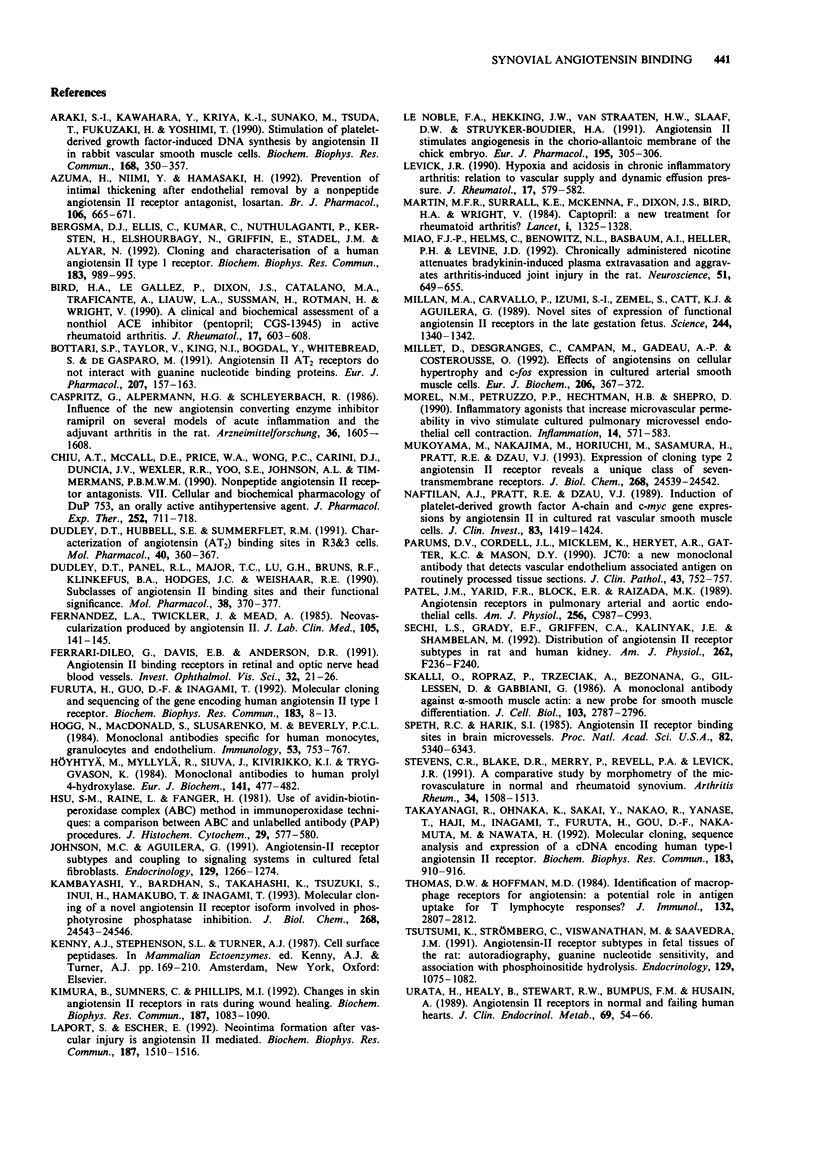
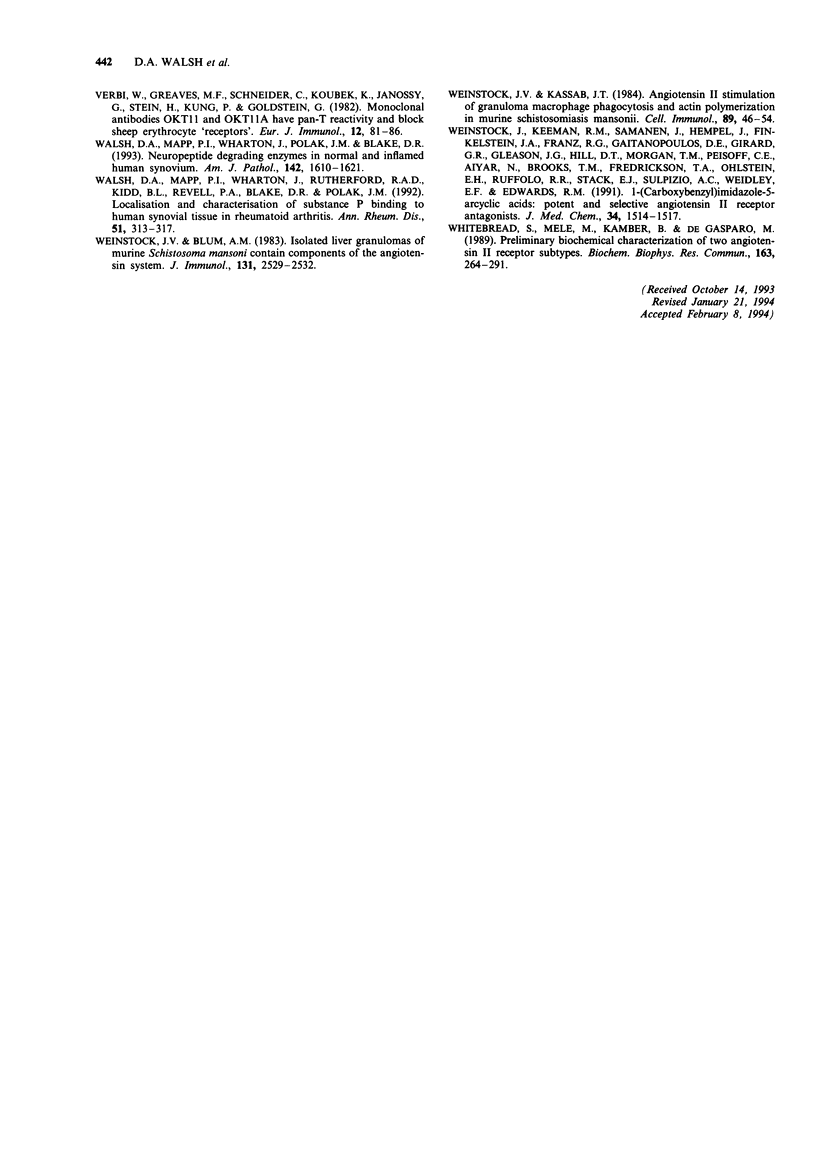
Images in this article
Selected References
These references are in PubMed. This may not be the complete list of references from this article.
- Araki S., Kawahara Y., Kariya K., Sunako M., Tsuda T., Fukuzaki H., Yoshimi T. Stimulation of platelet-derived growth factor-induced DNA synthesis by angiotensin II in rabbit vascular smooth muscle cells. Biochem Biophys Res Commun. 1990 Apr 16;168(1):350–357. doi: 10.1016/0006-291x(90)91715-5. [DOI] [PubMed] [Google Scholar]
- Azuma H., Niimi Y., Hamasaki H. Prevention of intimal thickening after endothelial removal by a nonpeptide angiotensin II receptor antagonist, losartan. Br J Pharmacol. 1992 Jul;106(3):665–671. doi: 10.1111/j.1476-5381.1992.tb14392.x. [DOI] [PMC free article] [PubMed] [Google Scholar]
- Bergsma D. J., Ellis C., Kumar C., Nuthulaganti P., Kersten H., Elshourbagy N., Griffin E., Stadel J. M., Aiyar N. Cloning and characterization of a human angiotensin II type 1 receptor. Biochem Biophys Res Commun. 1992 Mar 31;183(3):989–995. doi: 10.1016/s0006-291x(05)80288-8. [DOI] [PubMed] [Google Scholar]
- Bird H. A., Le Gallez P., Dixon J. S., Catalano M. A., Traficante A., Liauw L. A., Sussman H., Rotman H., Wright V. A clinical and biochemical assessment of a nonthiol ACE inhibitor (pentopril; CGS-13945) in active rheumatoid arthritis. J Rheumatol. 1990 May;17(5):603–608. [PubMed] [Google Scholar]
- Bottari S. P., Taylor V., King I. N., Bogdal Y., Whitebread S., de Gasparo M. Angiotensin II AT2 receptors do not interact with guanine nucleotide binding proteins. Eur J Pharmacol. 1991 Jun 19;207(2):157–163. doi: 10.1016/0922-4106(91)90091-u. [DOI] [PubMed] [Google Scholar]
- Caspritz G., Alpermann H. G., Schleyerbach R. Influence of the new angiotensin converting enzyme inhibitor ramipril on several models of acute inflammation and the adjuvant arthritis in the rat. Arzneimittelforschung. 1986 Nov;36(11):1605–1608. [PubMed] [Google Scholar]
- Chiu A. T., McCall D. E., Price W. A., Wong P. C., Carini D. J., Duncia J. V., Wexler R. R., Yoo S. E., Johnson A. L., Timmermans P. B. Nonpeptide angiotensin II receptor antagonists. VII. Cellular and biochemical pharmacology of DuP 753, an orally active antihypertensive agent. J Pharmacol Exp Ther. 1990 Feb;252(2):711–718. [PubMed] [Google Scholar]
- Dudley D. T., Hubbell S. E., Summerfelt R. M. Characterization of angiotensin II (AT2) binding sites in R3T3 cells. Mol Pharmacol. 1991 Sep;40(3):360–367. [PubMed] [Google Scholar]
- Dudley D. T., Panek R. L., Major T. C., Lu G. H., Bruns R. F., Klinkefus B. A., Hodges J. C., Weishaar R. E. Subclasses of angiotensin II binding sites and their functional significance. Mol Pharmacol. 1990 Sep;38(3):370–377. [PubMed] [Google Scholar]
- Fernandez L. A., Twickler J., Mead A. Neovascularization produced by angiotensin II. J Lab Clin Med. 1985 Feb;105(2):141–145. [PubMed] [Google Scholar]
- Ferrari-Dileo G., Davis E. B., Anderson D. R. Angiotensin II binding receptors in retinal and optic nerve head blood vessels. An autoradiographic approach. Invest Ophthalmol Vis Sci. 1991 Jan;32(1):21–26. [PubMed] [Google Scholar]
- Furuta H., Guo D. F., Inagami T. Molecular cloning and sequencing of the gene encoding human angiotensin II type 1 receptor. Biochem Biophys Res Commun. 1992 Feb 28;183(1):8–13. doi: 10.1016/0006-291x(92)91600-u. [DOI] [PubMed] [Google Scholar]
- Hogg N., MacDonald S., Slusarenko M., Beverley P. C. Monoclonal antibodies specific for human monocytes, granulocytes and endothelium. Immunology. 1984 Dec;53(4):753–767. [PMC free article] [PubMed] [Google Scholar]
- Hsu S. M., Raine L., Fanger H. Use of avidin-biotin-peroxidase complex (ABC) in immunoperoxidase techniques: a comparison between ABC and unlabeled antibody (PAP) procedures. J Histochem Cytochem. 1981 Apr;29(4):577–580. doi: 10.1177/29.4.6166661. [DOI] [PubMed] [Google Scholar]
- Johnson M. C., Aguilera G. Angiotensin-II receptor subtypes and coupling to signaling systems in cultured fetal fibroblasts. Endocrinology. 1991 Sep;129(3):1266–1274. doi: 10.1210/endo-129-3-1266. [DOI] [PubMed] [Google Scholar]
- Kambayashi Y., Bardhan S., Takahashi K., Tsuzuki S., Inui H., Hamakubo T., Inagami T. Molecular cloning of a novel angiotensin II receptor isoform involved in phosphotyrosine phosphatase inhibition. J Biol Chem. 1993 Nov 25;268(33):24543–24546. [PubMed] [Google Scholar]
- Kimura B., Sumners C., Phillips M. I. Changes in skin angiotensin II receptors in rats during wound healing. Biochem Biophys Res Commun. 1992 Sep 16;187(2):1083–1090. doi: 10.1016/0006-291x(92)91308-d. [DOI] [PubMed] [Google Scholar]
- Laporte S., Escher E. Neointima formation after vascular injury is angiotensin II mediated. Biochem Biophys Res Commun. 1992 Sep 30;187(3):1510–1516. doi: 10.1016/0006-291x(92)90473-x. [DOI] [PubMed] [Google Scholar]
- Le Noble F. A., Hekking J. W., Van Straaten H. W., Slaaf D. W., Struyker Boudier H. A. Angiotensin II stimulates angiogenesis in the chorio-allantoic membrane of the chick embryo. Eur J Pharmacol. 1991 Mar 26;195(2):305–306. doi: 10.1016/0014-2999(91)90552-2. [DOI] [PubMed] [Google Scholar]
- Levick J. R. Hypoxia and acidosis in chronic inflammatory arthritis; relation to vascular supply and dynamic effusion pressure. J Rheumatol. 1990 May;17(5):579–582. [PubMed] [Google Scholar]
- Martin M. F., Surrall K. E., McKenna F., Dixon J. S., Bird H. A., Wright V. Captopril: a new treatment for rheumatoid arthritis? Lancet. 1984 Jun 16;1(8390):1325–1328. doi: 10.1016/s0140-6736(84)91821-x. [DOI] [PubMed] [Google Scholar]
- Miao F. J., Helms C., Benowitz N. L., Basbaum A. I., Heller P. H., Levine J. D. Chronically administered nicotine attenuates bradykinin-induced plasma extravasation and aggravates arthritis-induced joint injury in the rat. Neuroscience. 1992 Dec;51(3):649–655. doi: 10.1016/0306-4522(92)90304-k. [DOI] [PubMed] [Google Scholar]
- Millan M. A., Carvallo P., Izumi S., Zemel S., Catt K. J., Aguilera G. Novel sites of expression of functional angiotensin II receptors in the late gestation fetus. Science. 1989 Jun 16;244(4910):1340–1342. doi: 10.1126/science.2734613. [DOI] [PubMed] [Google Scholar]
- Millet D., Desgranges C., Campan M., Gadeau A. P., Costerousse O. Effects of angiotensins on cellular hypertrophy and c-fos expression in cultured arterial smooth muscle cells. Eur J Biochem. 1992 Jun 1;206(2):367–372. doi: 10.1111/j.1432-1033.1992.tb16936.x. [DOI] [PubMed] [Google Scholar]
- Morel N. M., Petruzzo P. P., Hechtman H. B., Shepro D. Inflammatory agonists that increase microvascular permeability in vivo stimulate cultured pulmonary microvessel endothelial cell contraction. Inflammation. 1990 Oct;14(5):571–583. doi: 10.1007/BF00914277. [DOI] [PubMed] [Google Scholar]
- Mukoyama M., Nakajima M., Horiuchi M., Sasamura H., Pratt R. E., Dzau V. J. Expression cloning of type 2 angiotensin II receptor reveals a unique class of seven-transmembrane receptors. J Biol Chem. 1993 Nov 25;268(33):24539–24542. [PubMed] [Google Scholar]
- Naftilan A. J., Pratt R. E., Dzau V. J. Induction of platelet-derived growth factor A-chain and c-myc gene expressions by angiotensin II in cultured rat vascular smooth muscle cells. J Clin Invest. 1989 Apr;83(4):1419–1424. doi: 10.1172/JCI114032. [DOI] [PMC free article] [PubMed] [Google Scholar]
- Parums D. V., Cordell J. L., Micklem K., Heryet A. R., Gatter K. C., Mason D. Y. JC70: a new monoclonal antibody that detects vascular endothelium associated antigen on routinely processed tissue sections. J Clin Pathol. 1990 Sep;43(9):752–757. doi: 10.1136/jcp.43.9.752. [DOI] [PMC free article] [PubMed] [Google Scholar]
- Patel J. M., Yarid F. R., Block E. R., Raizada M. K. Angiotensin receptors in pulmonary arterial and aortic endothelial cells. Am J Physiol. 1989 May;256(5 Pt 1):C987–C993. doi: 10.1152/ajpcell.1989.256.5.C987. [DOI] [PubMed] [Google Scholar]
- Sechi L. A., Grady E. F., Griffin C. A., Kalinyak J. E., Schambelan M. Distribution of angiotensin II receptor subtypes in rat and human kidney. Am J Physiol. 1992 Feb;262(2 Pt 2):F236–F240. doi: 10.1152/ajprenal.1992.262.2.F236. [DOI] [PubMed] [Google Scholar]
- Skalli O., Ropraz P., Trzeciak A., Benzonana G., Gillessen D., Gabbiani G. A monoclonal antibody against alpha-smooth muscle actin: a new probe for smooth muscle differentiation. J Cell Biol. 1986 Dec;103(6 Pt 2):2787–2796. doi: 10.1083/jcb.103.6.2787. [DOI] [PMC free article] [PubMed] [Google Scholar]
- Speth R. C., Harik S. I. Angiotensin II receptor binding sites in brain microvessels. Proc Natl Acad Sci U S A. 1985 Sep;82(18):6340–6343. doi: 10.1073/pnas.82.18.6340. [DOI] [PMC free article] [PubMed] [Google Scholar]
- Stevens C. R., Blake D. R., Merry P., Revell P. A., Levick J. R. A comparative study by morphometry of the microvasculature in normal and rheumatoid synovium. Arthritis Rheum. 1991 Dec;34(12):1508–1513. doi: 10.1002/art.1780341206. [DOI] [PubMed] [Google Scholar]
- Takayanagi R., Ohnaka K., Sakai Y., Nakao R., Yanase T., Haji M., Inagami T., Furuta H., Gou D. F., Nakamuta M. Molecular cloning, sequence analysis and expression of a cDNA encoding human type-1 angiotensin II receptor. Biochem Biophys Res Commun. 1992 Mar 16;183(2):910–916. doi: 10.1016/0006-291x(92)90570-b. [DOI] [PubMed] [Google Scholar]
- Thomas D. W., Hoffman M. D. Identification of macrophage receptors for angiotensin: a potential role in antigen uptake for T lymphocyte responses? J Immunol. 1984 Jun;132(6):2807–2812. [PubMed] [Google Scholar]
- Tsutsumi K., Strömberg C., Viswanathan M., Saavedra J. M. Angiotensin-II receptor subtypes in fetal tissue of the rat: autoradiography, guanine nucleotide sensitivity, and association with phosphoinositide hydrolysis. Endocrinology. 1991 Aug;129(2):1075–1082. doi: 10.1210/endo-129-2-1075. [DOI] [PubMed] [Google Scholar]
- Urata H., Healy B., Stewart R. W., Bumpus F. M., Husain A. Angiotensin II receptors in normal and failing human hearts. J Clin Endocrinol Metab. 1989 Jul;69(1):54–66. doi: 10.1210/jcem-69-1-54. [DOI] [PubMed] [Google Scholar]
- Verbi W., Greaves M. F., Schneider C., Koubek K., Janossy G., Stein H., Kung P., Goldstein G. Monoclonal antibodies OKT 11 and OKT 11A have pan-T reactivity and block sheep erythrocyte "receptors". Eur J Immunol. 1982 Jan;12(1):81–86. doi: 10.1002/eji.1830120115. [DOI] [PubMed] [Google Scholar]
- Walsh D. A., Mapp P. I., Wharton J., Polak J. M., Blake D. R. Neuropeptide degrading enzymes in normal and inflamed human synovium. Am J Pathol. 1993 May;142(5):1610–1621. [PMC free article] [PubMed] [Google Scholar]
- Walsh D. A., Mapp P. I., Wharton J., Rutherford R. A., Kidd B. L., Revell P. A., Blake D. R., Polak J. M. Localisation and characterisation of substance P binding to human synovial tissue in rheumatoid arthritis. Ann Rheum Dis. 1992 Mar;51(3):313–317. doi: 10.1136/ard.51.3.313. [DOI] [PMC free article] [PubMed] [Google Scholar]
- Weinstock J. V., Blum A. M. Isolated liver granulomas of murine Schistosoma mansoni contain components of the angiotensin system. J Immunol. 1983 Nov;131(5):2529–2532. [PubMed] [Google Scholar]
- Weinstock J. V., Kassab J. T. Angiotensin II stimulation of granuloma macrophage phagocytosis and actin polymerization in murine schistosomiasis mansoni. Cell Immunol. 1984 Nov;89(1):46–54. doi: 10.1016/0008-8749(84)90196-5. [DOI] [PubMed] [Google Scholar]
- Whitebread S., Mele M., Kamber B., de Gasparo M. Preliminary biochemical characterization of two angiotensin II receptor subtypes. Biochem Biophys Res Commun. 1989 Aug 30;163(1):284–291. doi: 10.1016/0006-291x(89)92133-5. [DOI] [PubMed] [Google Scholar]



